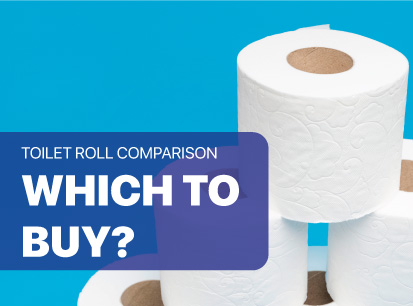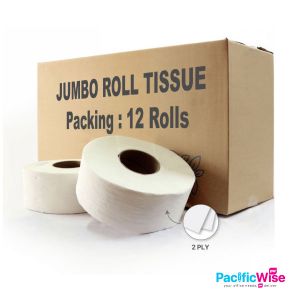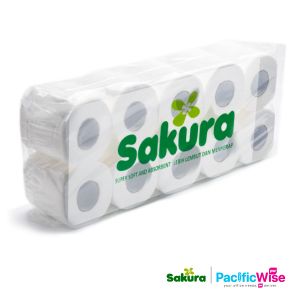This is a demo store. No orders will be fulfilled.
Why You Should Buy JRT Instead of Normal Toilet Roll?

JUMBO VS STANDARD TOILET PAPER ROLLS

Most modern restroom tissue dispensers hold at least two large rolls of toilet paper. Standard rolls are available in coreless versions and dispensers have grown to accomodate plumped-up standard rolls that are two to four times the size of the traditional roll. Jumbo dispensers hold huge rolls of tissue and are dispensed at the side rather than out the front of the dispenser. High-capacity jumbo rolls provide the equivalent of 10 or more standard rolls, and can reduce maintenance and product costs but also provide greater opportunity for waste as there is no way to control how much each occupant is using.

1) WHAT IS VIRGIN PULP?
• Virgin Pulp is a clean, wood-based raw material. It can be used to manufacture paper and various paper-based products while making them truly sustainable bioproducts at the same time.
• Virgin pulp and recycled pulp are two types of pulps that are made to manufacture paper.
• Virgin pulp is produced by chemically or mechanically separating cellulose fibres from woods or fibre crops.
• Virgin paper is the kind of paper that does not contain any recycled content and is made directly of the pulp of trees or cotton.
• This kind of paper is also considered to be a high-quality paper.
• Recycled pulp is made of used paper which has been processed by chemicals, so the inks will be removed with other unwanted elements and freed the paper fibres.
• Recycled pulp is safe to use as a raw material in paper manufacturing.
• Most of the facial tissues, toilet tissues and newsprints grade commonly contain 100% recycled pulp and in many other grades.
• Recycled paper is the kind of paper that was made from paper and paper products that have been used before and recovered.
• The papers produced with recycled pulp cannot be as sustainable as the ones produced by virgin pulp since in the recycling process fibres weaken and shorten.
• As a consequence of that, the recycled pulp can be used for a limited time. So, paper manufacturers have to use virgin pulp in order to maintain the paper cycle.
• The production of recycled pulp is harder and relatively more expensive than the production of virgin pulp.
• On the other hand, the production of recycled pulp has more steps which are paper collection and recovery, pulping and deinking.
• These steps take more time and require more money.
WHICH TYPE OF TOILET PAPER IS BEST FOR YOUR HOME OR WORK PLACE?
Not all toilet paper is created equally. Although they appear to be similar, the various toilet paper products available in grocery stores, pharmacies, bulk shopping membership stores, and online on janitorial supply websites have certain things that differentiate them from each other, such as size, weight, softness, and absorption. Since there are many different varieties of toilet paper for home and commercial use, first decide which type of toilet paper is best suited to your needs-1-ply versus 2-ply, standard versus jumbo, or coreless versus regular. But before you can decide what you need, you have to understand the differences in the various types of toilet paper.
There is 1-ply, 2-ply, and higher. What is thought of as commercial quality toilet paper is 1-ply and can have a small amount of non-pulped, non-bleached/paper in it. 2-ply paper has two stacked sheets and is therefore thicker and somewhat textured to provide more softness, generally a more luxurious or higher quality toilet paper. The second ply makes it both softer and more durable than 1-ply. The higher ply toilet tissue, or premium toilet paper, often has lotion or wax infused into the fibers and has two or more plies of very finely pulped paper in it. 2-ply toilet paper is the most commonly used worldwide, but 1-ply is also available in most countries as a less expensive option.
The difference between jumbo and standard toilet paper rolls is the size of the roll and the amount of toilet tissue on each roll. Jumbo toilet paper contains more toilet paper per roll than regular (or standard) toilet paper. Using jumbo toilet tissue should reduce costs and maintenance time because they need to be changed less frequently than standard rolls. Jumbo rolls are commonly used in commercial settings, such as office buildings, restaurants, or department stores. Jumbo toilet paper rolls require larger dispensers that can hold the jumbo rolls. Jumbo rolls come in both 1-ply and 2-ply varieties.
The difference between coreless and regular toilet tissue is whether or not the tissue is wound on a cardboard roll. Coreless paper provides more tissue per roll, and also requires a special coreless toilet paper dispenser. Jumbo coreless toilet paper is ideal for high-traffic areas such as offices, restaurants, or bars that have excessive toilet paper use. Jumbo rolls help to reduce run-outs and reduce costs because you have to change them less frequently than standard toilet tissue rolls. A coreless jumbo toilet paper roll is equivalent in length to nearly 5 standard toilet paper rolls. Coreless toilet paper also comes in 1-ply and 2-ply varieties.
Like all cleaning supplies, at a first glance all toilet paper appears to equal. Toilet paper products have differentiating factors including number of plies, size of the roll, and the core. Review the differentiating factors and then decide which type of toilet paper is best suited to your home or commercial needs.
https://mycleanlink.com/mycleanlink_blogs/b/cleanitsupply/posts/which-type-of-toilet-paper-is-best-for-your-home-or-work-place#:~:text=The%20difference%20between%20jumbo%20and,(or%20standard)%20toilet%20paper.















